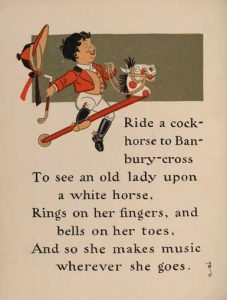
Have you ever wondered about the true meaning and history of a nursery rhyme, such as Ride a Cock-Horse to Banbury Cross? Most nursery rhymes represent a complex story behind it. There are many versions of Ride a Cock-Horse to Banbury Cross. It has changed and evolved over time.
There are versions that have been self-made and versions dating back to 1744, which you could find in Tommy Thumb’s Pretty Song Book. For the most part, these alternate versions were created in the UK, being related to the modern rhyme, Ride a Cock-Horse to Banbury Cross. The lyrics were altered many times into other stories so that the rhyme would make sense during that particular time.
The meaning of a “cock-horse” may mean that the horse is very exuberant. Giving the fact that the horse is “high-spirited”, then that may mean that the one controlling the horse is also very lively and living in the moment. There isn’t much evidence to support who the “fine lady” was, but we do know that this lady was a well-known figure in the 16th century.
The history of the “fine lady” having a bell on her toes mainly alludes to her fashion, but also music since wherever she goes galloping on her merry horse there will be music. If she is in a very happy mood, it’ll spread like wildfire through a forest, making her unstoppable. As to her horse, the horse itself will be connected to the “fine lady”, making them a force to be reckoned with.
All in all, the history of this story dates back to the Medieval Ages, where kings and queens ruled the lands. The rhyme represents that true happiness within one will spread to others, and today’s version has certainly brought joy to many children and their parents.